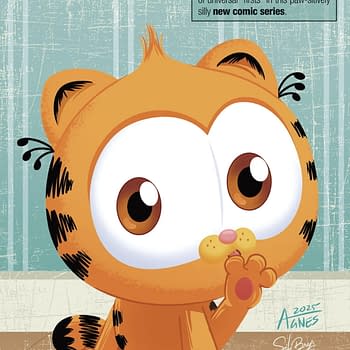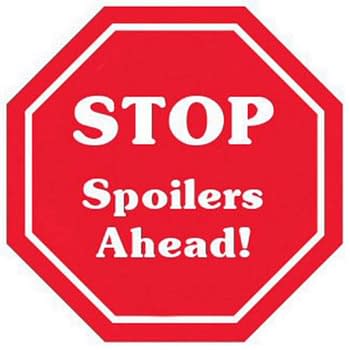Posted in: Comics | Tagged: Comics, Daniele Di Nicuolo, Elsa Charretier, entertainment, HRL, idw, Infinite Loop, Pierrick Colinet
Colinet And Charretier Talk 'The Infinite Loop: Nothing But The Truth'
Tomorrow will see the debut of The Infinite Loop: Nothing But The Truth, the second volume in the story by Pierrick Colinet and Elsa Charretier. They are joined in this second series for IDW Publishing by artist Daniele Di Nicuolo, who takes over on the art while Charretier moves to co-writer of the series. I had a chance to chat with Colinet and Charretier about the new series and the future for Teddy and Ano.
DAN WICKLINE: As we move into the new series, what do readers need to know about The Infinite Loop so they can jump right in on issue one of Nothing but the Truth? In the first series, Teddy's job was to find and remove anomalies in the time stream with Ulysses helping her. She's now helping to hide anomalies and Ano is in Congress. How is this timeline different going into the series, and what is that status of anomalies in it?
ELSA CHARRETIER: Since we really want this volume to be accessible to all readers — even those who haven't picked up Volume 1. We have a 'Previously' section at the beginning of issue #1 that sums it up nicely. But basically, human anomalies are not suppressed anymore (i.e. killed), thanks to Teddy and Ano's work, but are now parked in horrendous refugee camps.
Ano has decided to pursue her work the legal way, by being elected to Congress, and hopefully allow anomalies to be given the same rights as everyone. This gives us the opportunity to confront two ways of fighting for social change: the activist way, or the political way. The important thing to note is that we didn't want to repeat Volume 1, so although the fight for anomalies is still going on and Ano is fighting tooth and nail for them, it is less prominent in this volume.
DW: The new series introduces what seem to be memory helmets to help medicate people against depression, anxiety, and other ills. This could be taken as an analogy for either societies addiction to internet/virtual reality or the medical professions policy of overprescribing and medicating. What is the overall theme for this series, and do those things play into it?
PIERRICK COLINET: This is all of that. But most of all, the technology we've developed in the book, the American Day Dream head-sets (that allow people to live a life of fantasy or lose themselves into memories) is an allegory to Truth, and whether or not it's okay to lie to create hope. People lying to themselves, or politicians/governments lying to the people.
Although we have our own personal opinions on the current political climate, the idea was not to make a pamphlet, but rather delve into the different schools of thoughts when it comes to the importance of truth. We've assigned each character a specific view that relies on actual philosopher's work (Kant's, Rousseau's, and Nietzsche's), and have based out the structure of the book on how they'd confront their views, and the kind of conflict that would arise from that. It was a fascinating research process.
DW: How big have you planned this story to be? Will this series wrap up Teddy and Ano's arc? What do you see as the future of The Infinite Loop?
EC: This arc is a self-contained story; that's really important for us that people get the entire story in just four issues. That's actually often a good selling point. Readers follow so many ongoing series that it makes their buying decision a lot harder. They don't always want to commit to a new 24-issue series, so this format usually works well. The idea is the long run would be to keep doing stand-alone stories, and allow fans of Teddy and Ano to get their Infinite Loop fix once in a while!
DW: How does the collaboration process between the two of you as writers? Do you sit down and plot it out together then pass the script back and forth? Does one of you do the first pass and then the other tweaks?
PC: So what we'll usually do is, we'll first plot together. Go to a restaurant (yes, that makes the whole process even nicer!) with a pile of books and notepads, and just start talking about where we want the story to go. Over a series of lunch, we'll dig into characters, motivations, themes, and start breaking down issues. When we're pretty sure we have the broad lines, we'll start putting everything down on post-its, moving things around, refining structure. After that, I'll write a first draft.
I don't believe my scripts give too much direction, and I rarely write the type of shots I have in mind — I do picture them, but I'd rather allow the artist to come with their own vision, it definitely makes for a better book. Then Elsa will do her pass, give me her feedback and notes, and we rewrite the entire issue together. We've worked together for a while, so we pretty much know our respective strengths by now.
DW: Elsa, what made you decide to step away from doing the art as you did on the first series and just co-write?
EC: It was many different things. First, I had a lot of interior work planned on other titles, so it would have meant putting Volume 2 on hold for a lot longer. I had been involved with the writing on Volume 1, but I wasn't co-writing it per say, and I kind of felt the itch to push in that direction. And writing a script you won't be drawing is a completely different experience — it felt like a new challenge I wanted to tackle.
I sometimes have "Oh damn, now I want to draw that!" moments. That's usually a pretty good indication that we had fun writing it, and hopefully Daniele will have fun on the page.
DW: How did you decide on Daniele Di Nicuolo as the artist for the second series? What does Daniele bring to the series that outshined other choices?
EC : We wanted someone who would have a very different style from my own, to avoid comparison. I have a more '50s classic vibe, when he tends to lean more toward manga. Which is actually perfect, because this volume has a lot of action and fighting and Daniele is absolutely fantastic at that. His work on Power Rangers: Pink (I did covers for the mini-series and that's how we discovered his work) was outstanding, and we felt he'd bring a unique touch to the book.
And he is also a fantastic guy, super fun to work with, eager to give all his energy. Creator-owned is about working with partners, and we got along great right from the beginning.
DW: For the folks who haven't picked up the series yet, give me the two-sentence Hollywood elevator pitch for the series. Why should new readers seek out the trade and the new series?
PC: Teddy, our main character, finds herself in a town where people are addicted to head-sets that project a life of fantasy, a life of lies. As the subtitle states it and as I said above, this new volume is about truth and perception. We intersect these somehow theoretical themes to the much more pragmatic opioid epidemic in West Virginia, and delve into this specific question: is it okay to lie to people to create hope?




















